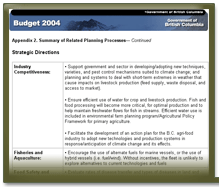 |
|
|
2004/05 – 2006/07 SERVICE PLAN
Ministry of Agriculture, Food and Fisheries
Appendix 2. Summary of Related Planning Processes
Human Resource Management Plan
The ministry has implemented a comprehensive human resource management
plan to address the immediate and long-term human resource needs
to deliver this service plan. The ministry will carry out the
plan within the context of the following vision and strategies:
Vision:
The Ministry of Agriculture, Food and Fisheries is committed to
a supportive, rewarding and motivating work environment where employees
are valued and service excellence is achieved.
It encompasses the following broad strategies:
Effective People Strategy
- Developing effective recruitment and retention strategies to
enable the ministry to deliver on its service plan objectives.
Proactive and Visionary Leadership
- Developing leaders in the workforce who will continue to expand
on the vision for the public service of the future.
Performance Focused Workplace
- Establishing and implementing performance-based systems that
ensure the ministry is achieving its service plan objectives in
the most efficient and effective manner.
Flexible and Motivating Work Environment
- Establishing and implementing options for flexible work environments
to ensure maximum physical and emotional well-being.
- Providing opportunities for career development.
Learning and Innovative Organization
- Implementing personal learning plans for employees to maintain
and improve their expertise.
Progressive Employee-Employer Relations
- Promoting ongoing regular communications between executive,
managers and staff to maximize feedback and develop a relationship
of trust and mutual respect.
Information Resource Management Plan
Strategic Direction
The Ministry of Agriculture, Food and Fisheries has adopted the
following strategies:
- Provide web-enabled service delivery where feasible so the public
can access more information electronically while allowing staff
to respond to relevant client inquiries.
- Manage within a more limited budget with creative approaches
in office computer systems.
- Use common information technology, infrastructure and management
concepts to ensure stable, secure, and functional computer systems.
Major Projects
- Further expansion of InfoBasket: The ministry's award-winning
portal, InfoBasket, will continue to be expanded with the addition
of more business focus areas addressing specific commodity groups.
The site now has sheep and lambs, specialty crops, bison, agroforestry,
micro-food processors, as well as organics and ornamentals.
- Replacement of aging computerized licensing systems:
The ministry will continue with projects to replace its aging
commercial fisheries and aquaculture licensing systems. During
fiscal /03, the requirements phase was undertaken with design
and build phases planned for 2004/05. The intent is to use the
ministry's common licensing system as much as possible for all
the licences it issues.
Climate Change
B.C. is working with the federal government as part of the Agricultural
Policy Framework agreement to meet a target for the reduction in
greenhouse gas emissions. Under the agreement, Canada and B.C. have
committed to reducing greenhouse gas emissions by eight per
cent from the estimated baseline in 2008 if business continued as
usual. As the ministry implements the Agricultural Policy Framework,
it will develop supporting strategies to reach the proposed target.
Risks
The threat of climate change poses several risks to the agriculture,
food and fisheries sectors:
- changes in cropping patterns/potential reductions in dryland
crop yield potential
- potential increases in crop damage
- water shortages in some areas and potential excess supply in
other areas
- changes in the interactions among crops, weeds, insects, and
disease
- increased potential for greater fluctuations in weather patterns
with more severe and frequent extremes (e.g., storms, or droughts)
which may increase the occurrence of weather/climate related disasters
and lead to crop and farm structure related losses.
Opportunities
- access to federal program funding including the environmental
farm planning program and the green cover program
- growing different crop varieties to respond to climate change
- potential to increase crop yields, provided water supply can
be supplemented by irrigation
- expansion of crop and livestock production in (currently) cooler
more northern areas
- expand carbon sequestration through improved management practices
- trading of carbon sequestered in agricultural soils.
|
|



